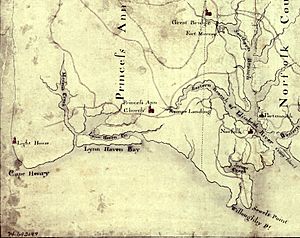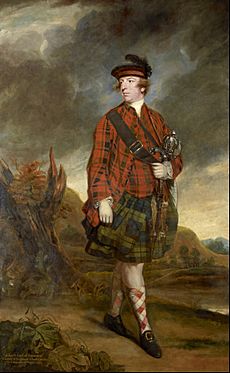Battle of Kemp's Landing facts for kids
Quick facts for kids Battle of Kemp's Landing |
|||||||
|---|---|---|---|---|---|---|---|
| Part of the American Revolutionary War | |||||||
 Detail of a 1770s map of eastern Virginia. Oriented with North at the bottom of the map, Kemp's Landing is near the center of the map, and Norfolk is to its right (west). |
|||||||
|
|||||||
| Belligerents | |||||||
|
|
||||||
| Commanders and leaders | |||||||
| Joseph Hutchings (POW) Anthony Lawson |
John Murray, 4th Earl of Dunmore | ||||||
| Strength | |||||||
| 170 militia | 100 infantry 20 militia |
||||||
| Casualties and losses | |||||||
| 7 killed 18 captured |
1 wounded | ||||||
The Battle of Kemp's Landing, also known as the Skirmish of Kempsville, was a small fight during the American Revolutionary War. It happened on November 15, 1775, in Virginia.
Local volunteer soldiers, called militia, gathered at Kemp's Landing. They wanted to stop British troops led by Virginia's governor, Lord Dunmore. Dunmore had landed nearby at Great Bridge. He was looking for American soldiers from North Carolina, but they weren't there. Instead, he found the local militia. Dunmore's troops defeated the militia, even though the Americans tried to set up a surprise attack.
After his victory, Lord Dunmore announced a special rule called martial law. He also promised freedom to enslaved people who belonged to American supporters if they joined the British army. This made many people even more angry with him. Eventually, he had to leave Virginia.
Contents
Why the Battle Happened
Things were getting very tense in the British Colony of Virginia in April 1775. This was around the same time that the American Revolutionary War began with fighting in Massachusetts.
Rising Tensions in Virginia
People who wanted independence, called Patriots (or Whigs), started gathering troops. They wanted to control the colony's military supplies. Lord Dunmore, the British governor of Virginia, ordered British soldiers to take gunpowder from a storage building in Williamsburg. This worried the Patriots.
Even though no one was hurt in that event, Dunmore feared for his safety. He left Williamsburg in June 1775. He moved his family onto a British Navy ship. Then, he gathered a small British fleet in Norfolk. Many merchants in Norfolk were Loyalists (or Tories), meaning they supported the British King.
Dunmore's Actions and Proclamation
Small fights continued between Patriots and Loyalists. By October, Dunmore had enough military support to start operations. He sent British troops to raid nearby areas for rebel supplies.
Later, a small British ship got stuck and was captured by Patriots near Hampton. British Navy boats tried to punish the townspeople. But American soldiers and militia fought them off. Several British sailors were killed or captured.
In response, Dunmore wrote a special announcement on November 7. He declared martial law, which meant the military would take control. He also offered freedom to enslaved people who belonged to Patriots if they joined the British Army. He didn't tell everyone right away. But he did get enough enslaved people to form a group called the Ethiopian Regiment. He also formed a group of Loyalists called the Queen's Own Loyal Virginia Regiment. These local groups joined the few British soldiers already in Virginia.
Getting Ready for Battle
Virginia's Committee of Safety started getting troops ready in Williamsburg. They planned to send them to Norfolk to deal with Dunmore.
American Forces Gather
Colonel William Woodford led these American forces. They couldn't leave Williamsburg until November 7 because they lacked equipment. British ships sent by Dunmore blocked them from crossing the James River for a week.
Meanwhile, Dunmore was on a British Navy ship. On November 14, he landed 109 soldiers and 22 volunteers near Great Bridge. He was checking rumors that American militia had arrived from North Carolina. The rumors were false.
Militia at Kemp's Landing
Dunmore's landing made the militia of Princess Anne County gather. About 170 men answered the call. Joseph Hutchings, the local militia leader, and Anthony Lawson, a local landowner, led them. They met at Kemp's Landing, which was about 10 miles (16 km) from Great Bridge. They planned a surprise attack along the road to Great Bridge.
The next day, Dunmore found out the rumors about North Carolina troops were false. But he heard about the militia at Kemp's Landing. He left some troops to guard the bridge. Then, he took 100 regular soldiers and 20 Loyalists toward Kemp's Landing.
The Fight at Kemp's Landing
The American militia's surprise attack didn't work. Hutchings' inexperienced soldiers fired too early.
Dunmore's well-trained soldiers fired back. They moved through the woods to find the rebels. The militia scattered and ran away. During the chase, Hutchings was captured by one of his former enslaved people. Lawson escaped the battle but was captured a few days later. In total, 18 American Patriots were captured and seven were killed. Only one British soldier had a minor injury.
What Happened Next
After taking control of the town, Dunmore raised the British flag. He then read his special announcement to everyone.
Dunmore's Proclamation and Norfolk
The next day, more than 100 militiamen who had fought against him swore loyalty to the British King. They claimed the Patriots had forced them to fight. Dunmore then moved to Norfolk. There, he again raised the flag and started building defenses.
Colonel Woodford's American forces finally reached Great Bridge. They were joined by soldiers from North Carolina. This made Dunmore order an attack against them. On December 9, Woodford won a big victory in the Battle of Great Bridge.
After this loss, Dunmore left Norfolk. The town was then burned on January 1, 1776, by both Patriot and Loyalist actions. Dunmore continued to raid Virginia's coastal towns until August 1776. Then, he left for New York City.
Later History of Kempsville
Kemp's Landing became a town called Kempsville in 1778. It became the main town for Princess Anne County. Princess Anne County later joined with Virginia Beach in 1963. Today, Kempsville is a neighborhood within Virginia Beach.


